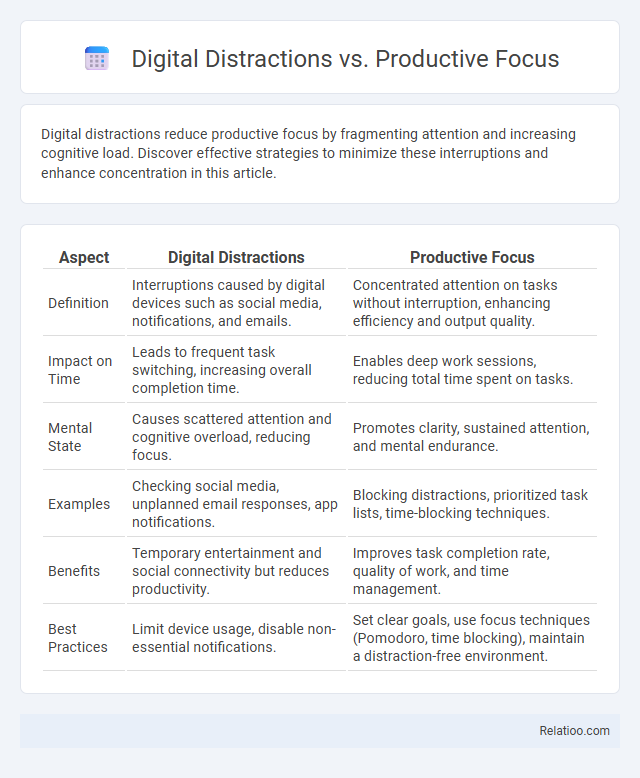Digital distractions reduce productive focus by fragmenting attention and increasing cognitive load. Discover effective strategies to minimize these interruptions and enhance concentration in this article.
Table of Comparison
| Aspect | Digital Distractions | Productive Focus |
|---|---|---|
| Definition | Interruptions caused by digital devices such as social media, notifications, and emails. | Concentrated attention on tasks without interruption, enhancing efficiency and output quality. |
| Impact on Time | Leads to frequent task switching, increasing overall completion time. | Enables deep work sessions, reducing total time spent on tasks. |
| Mental State | Causes scattered attention and cognitive overload, reducing focus. | Promotes clarity, sustained attention, and mental endurance. |
| Examples | Checking social media, unplanned email responses, app notifications. | Blocking distractions, prioritized task lists, time-blocking techniques. |
| Benefits | Temporary entertainment and social connectivity but reduces productivity. | Improves task completion rate, quality of work, and time management. |
| Best Practices | Limit device usage, disable non-essential notifications. | Set clear goals, use focus techniques (Pomodoro, time blocking), maintain a distraction-free environment. |
Understanding Digital Distractions
Digital distractions, such as social media notifications and instant messaging, significantly reduce your productive focus by fragmenting attention and increasing cognitive load. Understanding digital distractions involves recognizing how constant interruptions impair task performance and extend completion time, leading to decreased efficiency. Managing these distractions effectively requires strategies like time-blocking and disabling non-essential alerts to maintain sustained focus and minimize interference.
The Science Behind Attention and Focus
The science behind attention and focus reveals how digital distractions hijack your brain's cognitive resources, reducing productivity and increasing mental fatigue. Productive focus relies on the ability to maintain selective attention through sustained effort, which digital interruptions often fragment, leading to interference in task completion. Understanding neural mechanisms such as the prefrontal cortex's role in executive control can help you develop strategies to minimize distractions and optimize concentration.
Common Sources of Digital Distractions
Common sources of digital distractions include social media notifications, email alerts, and instant messaging apps that constantly interrupt workflow. Streaming services and online gaming platforms also contribute significantly to reduced productivity by pulling attention away from tasks. Understanding and managing these digital interruptions is essential for maintaining productive focus and minimizing interference in work environments.
The Impact of Technology on Productivity
Technology's pervasive presence introduces digital distractions such as social media notifications and non-essential apps, significantly reducing productive focus by fragmenting attention. These interruptions lead to cognitive interference, impairing the brain's ability to maintain deep work states essential for complex problem solving and creativity. Implementing digital wellness strategies, including app management and scheduled focus periods, can mitigate technology-induced disruptions, enhancing overall workforce productivity.
Detecting the Signs of Digital Overload
Detecting the signs of digital overload involves recognizing constant multitasking, frequent distractions from notifications, and decreased attention span that impair your ability to maintain productive focus. Digital distractions create interference by fragmenting your cognitive resources, leading to mental fatigue and reduced task efficiency. Identifying these symptoms early allows you to implement strategies that restore concentration and optimize your workflow.
Strategies to Boost Productive Focus
To boost productive focus amidst digital distractions and interference, implement time-blocking techniques that allocate specific periods for deep work free from notifications. Optimize your environment by minimizing digital clutter and using apps that limit access to distracting websites, enhancing your ability to sustain attention. Prioritize task management with clear goals and regular breaks to maintain cognitive energy and improve overall efficiency.
Tools and Apps to Minimize Distractions
Tools and apps designed to minimize digital distractions enhance productive focus by blocking access to distracting websites, managing notifications, and setting time limits for app usage. Popular solutions like Freedom, StayFocusd, and Forest employ techniques such as website blocking, Pomodoro timers, and gamification to reduce interference during work sessions. Integrating these tools into daily routines significantly improves concentration, reduces task-switching, and promotes sustained attention on high-priority activities.
Building Healthy Digital Habits
Building healthy digital habits requires recognizing the fine line between digital distractions, productive focus, and interference. Prioritizing tasks through time-blocking and utilizing tools like website blockers enhances focus while minimizing disruptions. Integrating mindfulness practices and regular digital detoxes promotes sustained productivity and reduces cognitive overload caused by constant notifications and multitasking.
Establishing a Distraction-Free Work Environment
Creating a distraction-free work environment involves minimizing digital interruptions such as social media notifications, email alerts, and non-essential app usage that hinder your productive focus. Implementing strategies like using website blockers, setting specific time blocks for deep work, and organizing your digital workspace reduces interference and enhances concentration. Prioritizing these methods supports sustained attention, leading to higher efficiency and improved task completion.
Sustaining Long-Term Focus in a Digital World
Sustaining long-term focus in a digital world requires strategic management of digital distractions, which often lead to cognitive interference and reduced productivity. Employing techniques like time-blocking, digital detoxes, and mindfulness can enhance productive focus by minimizing interruptions from notifications and multitasking demands. Research highlights that consistent practice of these methods supports improved attention span and cognitive control, essential for maintaining sustained concentration amid pervasive digital stimuli.

Infographic: Digital Distractions vs Productive Focus
 relatioo.com
relatioo.com